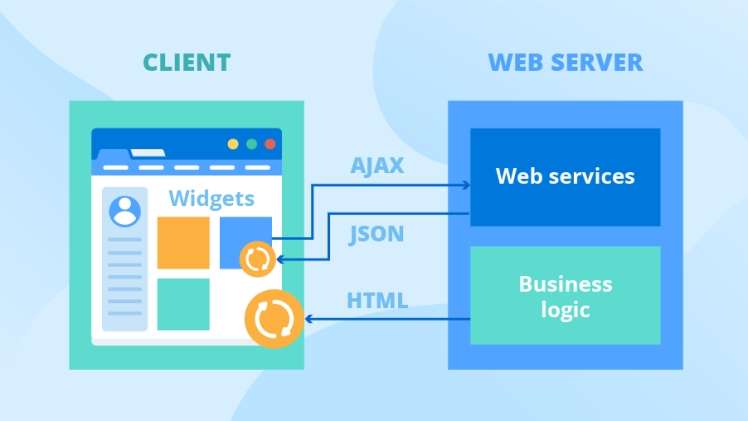Introduction of Web Application Architecture.
Web application architecture interacts between web applications, databases, and middleware systems. Web application architecture ensures that many applications can run at the same time. Let’s take a look at how to open a webpage as an example. When a user types a URL into the address bar of a web browser and presses the go button. Then the browser requests the URL. As a response to the request, the server sends files to the browser. After that, the browser runs certain files in order to display the requested page. Finally, the website allows the user to communicate with web application architecture. The code parsed by the web browser is the most important thing to remember here.
More about Web Application Architecture.
Similarly, a mobile app operates. This code may or may not include explicit instructions. These instructions tell the browser how to react to various types of user inputs. As a result, web application architecture must include all sub-components. Also, external applications interchanges for the entire software application. Since a large portion of global network traffic, also most applications and devices use web-based connections. Furthermore, web application architecture is essential in today’s world.
What Is the Process?
In a typical web application, two different codes (sub-programs) are running concurrently. These are the following:
1. Client-side code is code that resides in the browser and reacts to user input.
2. server-side code. The code that runs on the server and responds to HTTP requests.
Web developer: A web developer (team) working on the web application decides the operation to do in relation to the browser code. C#, Java, JavaScript, Python, PHP, Ruby, and other languages are used to write server-side code.
A server is capable of running any code that can respond to HTTP requests. The server-side code is in charge of generating the requested page as well as storing various types of data, such as user profiles and user input. The end-user remains ignorant about it.
client-side code: The client-side code is developed utilizing a ratio of CSS, HTML, and JavaScript. The web browser decodes this code. Client-side code, unlike server-side code, can be viewed and modified by the user. It responds to the input of the user.
The client-side code can only communicate with the server via HTTP requests and cannot read files directly from the server.
Web Application Components
DNS
DNS is a basic system that helps to search for the name of the domain and the IP address and thus receives a request from a specific server from the user. Therefore, we might claim DNS is like a phonebook, except for websites on the Internet.
Balancing Load
The main focus of Load Balancer is on horizontal scaling. The Load Balancer sends a response to the user with incoming requests to one of the various servers. In general there are servers for the Web applications that mirror one another in multiple copies. So any server processes requests in the same way, and the load balancer distributes tasks between them.
Servers of Web Apps
This component processes the request of a user and returns documents (JSON, XMK, etc.) to a browser. This task usually involves back-end infrastructures such as a database, a cache server, a job queue, and other services. In addition, the user’s requests can be processed at least by two servers connected to the load balancer.
Bases of Data
The name of this component of this web application speaks for itself. Resultantly, the database provides tools to organize, add, and perform computations. Therefore, web application servers interact directly with work servers mostly.
Service of Cache
Caching is a data storage service that allows you to store and search data. Then the results of the request are saved in the cache. As a result, future requests will be processed more quickly. In a nutshell, caching helps you to refer to a previous result. The aim remains to speed up a calculation. As a result, caching is successful when:
The computation is slow. The computation is likely to occur several times. And the results for a specific request are the same.
Services provision
It creates services in the form of separate apps when a web application reaches a certain level. They are not as visible as other web application components. But they interact with the web application and other services.
Warehouse of Data
Almost every modern application necessitates the collection, storage, and analysis of data. There are three stages to these processes:
- The information is sent to a data “firehose,” which provides a streaming interface for data absorption and processing.
- It sends data to cloud storage in its raw, processed, and additional forms.
- A data warehouse also receives processed and additional data.
It’s a specific type of online data storage. Also, an exchange model that uses the Internet. Therefore, Data Warehouse can be used to store a variety of file types. Likewise, including videos, photos, and other media.
CDN
The CDN, or Content Delivery Network, is responsible for sending HTML, CSS, JavaScript, and image files. It distributes the end server’s content around the world, allowing people to access a variety of sources.
Conclusion
The design of software applications such as the Internet continues to evolve. The reign of Platform 1.0 was the most fundamental paradigm of the web application architecture. It took its current form, however, after the rise of Web 2.0 and Web 3.0. The model and form of web app architecture you select notably affect the model. Furthermore, form of web app architecture you select. Therefore, take the time to discuss all conditions, objectives, and choices before starting production.

Leave a Reply
You must be logged in to post a comment.